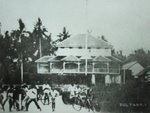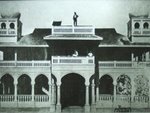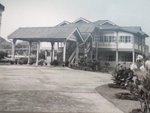
I have always been curious as the three warships that Brunei is supposed to have bought. I know we paid a fortune for it. According to BBC the three ships cost the Brunei Government some GBP600 (about $1.9 billion our money). In 1998/1999, when oil price plunge to about US$10 a barrel, this price was more than what the government was earning in a year. I found two interesting articles. The first written about the ships sometime in 2003 and the second is what is happening to the ships now and written sometime Jun 2007.
(A) First Article - written by Dave Cullen [European WARSHIPS IFR magazine(*)]
Three new corvettes built on the Clyde for The Royal Brunei Navy.
BAE SYSTEMS Marine is completing contractor's sea trials of NAKHODA RAGAM, the first of a new class of three 95m Offshore Patrol Vessels (OPVs) being built for the Royal Brunei Navy. She is due to sail from Scotland to the Far East by the end of the year.
The ships names are prefixed KDB (as in Kapal Diraja Brunei, which translates as Ship of the Rajah of Brunei) and BENDAHARE SAKAM, the second ship of the class, was launched in June 2001. She has completed diesel generator trials in dry dock at BAE SYSTEMS' Scotstoun yard and is under-going contractor's sea trials with delivery in June 2003.
The third and final vessel, named KDB JERAMBAK, was launched in June 2002 and is scheduled to be delivered in December 2003.
A variant of the generic F2000 series corvette design, Royal Brunei Technical Services Sdn Bhd is procuring the ships under a UK/Brunei government-to-government contract signed in January 1998. The design is a reduced version of the Lekiu Class built by the same yard for Malaysia and they have cost around US $350 million each. With a displacement of approximately 1,500 tons standard and 2,000 tons full load, the new Brunei OPVs have a maximum speed of 30 knots and a range of 5,000 nautical miles at 12 knots.
Endurance will be 14 days and they will have a crew of 62 (including eight officers) and 24 berths for Flag Staff and scientists. They are powered by four Paxman diesels turning two controlled-pitch propellers, and their hulls are fitted with fin stabilisers. One generator is able to meet normal loads. The new ships feature a comprehensive combat system based around the hub of an Alenia Marconi Systems (AMS) NAUTlS II command and fire-control system.
AMS is also supplying AWS-9(3D) E/F-band surveillance and target indication radar and two 1802SW radar trackers.
The vessels are armed with:
· Eight MBDA MM40 Block 2 Exocet Surface-to-Surface Missiles (SSMs).
· An MBDA Vertical Launch Sea Wolf installation containing 16 Surface-to-Air-Missiles (SAMs).
· A single Otobreda 76/62 Super Rapid gun.
· Two MSI-Defence DS 30B REMSlG guns.
· A Close-In Weapons System (CIWS).
A flight-deck aft provides for the operation of a Seahawk-size helicopter, but there is no hangar facility. Other systems include a Radamec System 2500 electro-optical director and TMS 4130C hull-mounted sonar supplied by Thales Underwater Systems (the sonar incorporates a torpedo warning capability). Thales Sensors is supplying its Cutlass 242 ESM and Scorpion jammer, and Wallop Defence Systems is providing the Super Barricade decoy system.
The Royal Brunei Navy
The three new OPVs will be based at Brunei's main naval base in Muara, in the South China Sea and represent a significant enhancement for a small fleet.
The Royal Brunei Navy has a total personnel strength of 800 staff (including 65 officers) and a Special Combat Squadron of six officers and 114 men for river duties.
The main threat has traditionally come from neighbouring Indonesia, although the Chinese are likely to pose a future concern and Islamic terror groups cannot be discounted as a security headache for the oil-rich sultanate. Britain has strong defence links with Brunei, with a Gurkha infantry battalion and an Army Air Corps helicopter flight permanently stationed there. UK Royal Marines regularly train at the UK's jungle warfare school in Brunei. The advent of the new corvettes will no doubt lead to regular exercises not only with regional allies, such as Singapore and Malaysia, but also with the RAN, Royal Navy and US Navy. Singapore maintains 500 troops and a helicopter detachment in Brunei.
By 2003 the Royal Brunei Navy will consist of:
3 x F2000 corvettes
3x Waspada guided-missile Patrol Craft, armed with Exocet Surface-to-Surface Missiles.
3 x Perwira Class inshore Patrol Boats.
2 x Amphibious Warfare Craft
2 x Landing Craft
17 x Small Armed River Craft (for the Special Combat Squadron)
1 x Support Launch
23 x Marine Police Patrol Boats.
(B) Second Article - from BBC News Website
Brunei warships to go on sale
Construction was completed at BAE Systems in Scotstoun
Three warships built at BAE shipyard in Glasgow for the Royal Brunei Navy are finally to be sold after a long-running legal dispute was resolved.
A £600m deal between BAE Systems and Brunei was signed in 1998, resulting in the completion of three coastal patrol frigates by 2004.
However the Sultan of Brunei claimed the ships were not as he had ordered, and they remained berthed in Scotstoun.
The arbitration dispute ended in May, allowing the ships to be sold on.
Following finalisation of contracts, the ships were able to be handed over to the Royal Brunei Technical Services (RBTS), which is the Brunei's equivalent of the Ministry of Defence.
A spokesman for BAE Systems said that the shipbuilders had been paid for the completion of the ships, and that the ships had now been handed over to RBTS.
He declined to comment on any alleged problems with the specification of the ships or on the company's relationship with Brunei.
A German company, Lurssen, is said to be acting as an agent for Brunei for the sale of the three vessels.
The ships, the KDB Nakhoda Ragam, KDB Bendhara Sakam and KDB Jerambak, were originally destined for the Offshore Patrol Vessel (OPV) squadron of the Royal Brunei Navy.

















